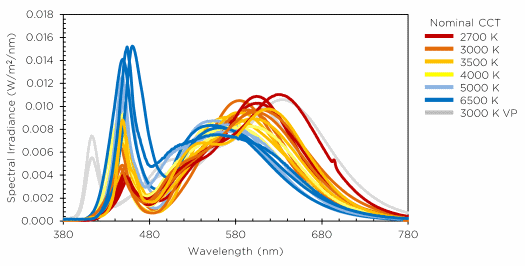The spectral emission of LEDs is a frequent subject of concern, so to set the record straight, the U.S. Department of Energy has published a technical brief entitled True Colors: LEDs and the Relationship Between CCT, CRI, Optical Safety, Material Degradation, and Photobiological Stimulation . Using an example dataset of 20 CALiPER-tested LED lighting products that cover the full range of market-available CCTs and CRIs, it separates myth from fact regarding the potential of LEDs to cause retinal damage, changes to artwork or other media, and stimulation of the human circadian system (which impacts health).

Figure 1. The spectral power distribution of LED products can vary substantially based on the desired CCT and CRI, even among “standard” blue-pump, phosphor converted products. The 20 products included in this chart were used to analyze the relationship between color metrics (CCT, CRI, Duv) and concerns associated with blue light content (optical safety, material safety, and photobiological safety). Two violet-pump (VP) LED products were also considered separately. All SPDs were scaled to represent equal luminous flux.
Too much exposure to “blue light”—or radiant energy with wavelengths between about 400 and 480 nm—is known to cause retinal damage, and the spectral power distributions of LEDs feature a peak in the short-wavelength blue region (around 450 nm) as well as a broader peak somewhere between 550 and 650 nm. But this doesn't mean LEDs are more likely than other sources to cause retinal, material, or circadian harm. In fact, those risks are roughly the same for typical commercially available LEDs as for other source types with the same CCT—because they all generally contain equivalent amounts of blue light. In general, CCT can be used as a basic predictor of short-wavelength content across various source types, and specifically as a predictor of optical safety, material degradation, and circadian stimulation. Get more information at http://www1.eere.energy.gov/buildings/ssl/pdfs/true-colors.pdf
Advertisement





